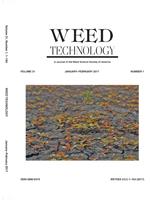Poor annual bluegrass control was reported in golf course roughs following treatment with prodiamine (1120 gaiha−1) and glyphosate (840 gaeha−1) during hybrid bermudagrass dormancy. Research was conducted to determine if this annual bluegrass phenotype was resistant to both prodiamine and glyphosate and to determine the efficacy of herbicide mixtures for controlling this phenotype in the field. In PRE or POST dose-response experiments, 9 to 31 times more prodiamine or glyphosate was needed to control (or reduce dry biomass of) this resistant phenotype by 50% compared to an herbicide-susceptible phenotype. Moreover, glyphosate-susceptible plants accumulated 50% more shikimic acid (898 mgkg−1) 6 d after treatment than those resistant to glyphosate (394 mgkg−1). October (fall) applications of herbicide mixtures containing trifloxysulfuron, simazine, S-metolachlor, or mesotrione controlled this resistant annual bluegrass phenotype 84 to 98% in April (spring), with no differences detected among treatments. Our findings document the second instance of annual bluegrass evolving multiple resistance in a managed turfgrass system. However, several herbicide mixtures can be used to effectively manage this resistant phenotype.
Nomenclature: glyphosate; mesotrione; prodiamine; simazine; S-metolachlor; trifloxysulfuron; annual bluegrass, Poa annua L.; hybrid bermudagrass, Cynodon dactylon×Cynodon transvaalensis Burtt-Davy.
Control limitado de Poa annua fue reportado en “roughs” de campos de golf después de tratamientos con prodiamine (1120 g ai ha−1) y glyphosate (840 gaeha−1) durante el período de dormancia del césped bermuda híbrido. Se realizó una investigación para determinar si este fenotipo de P. annua era resistente a prodiamine y glyphosate y para determinar la eficacia de mezclas de herbicidas para controlar este fenotipo en el campo. En experimentos de respuesta a dosis con herbicidas PRE o POST, se necesitó de 9 a 31 veces más prodiamine o glyphosate para controlar (o reducir la biomasa seca) de este fenotipo resistente en 50% en comparación a un fenotipo susceptible a estos herbicidas. Además, plantas susceptibles a glyphosate acumularon 50% más ácido shikimic (898 mg kg−1) 6 d después del tratamiento que plantas resistentes a glyphosate (394 mg kg−1). Aplicaciones en Octubre (otoño) de mezclas de herbicidas que contenían trifloxysulfuron, simazine, S-metolachlor, o mesotrione controlaron este fenotipo resistente de P. annua 84 a 98% en Abril (primavera), sin detectarse diferencias entre estos tratamientos. Nuestros resultados documentan la segunda instancia de P. annua que evoluciona resistencia múltiple en un sistema manejado de céspedes. Sin embargo, varias mezclas de herbicidas pueden ser usadas para manejar efectivamente este fenotipo resistente.





